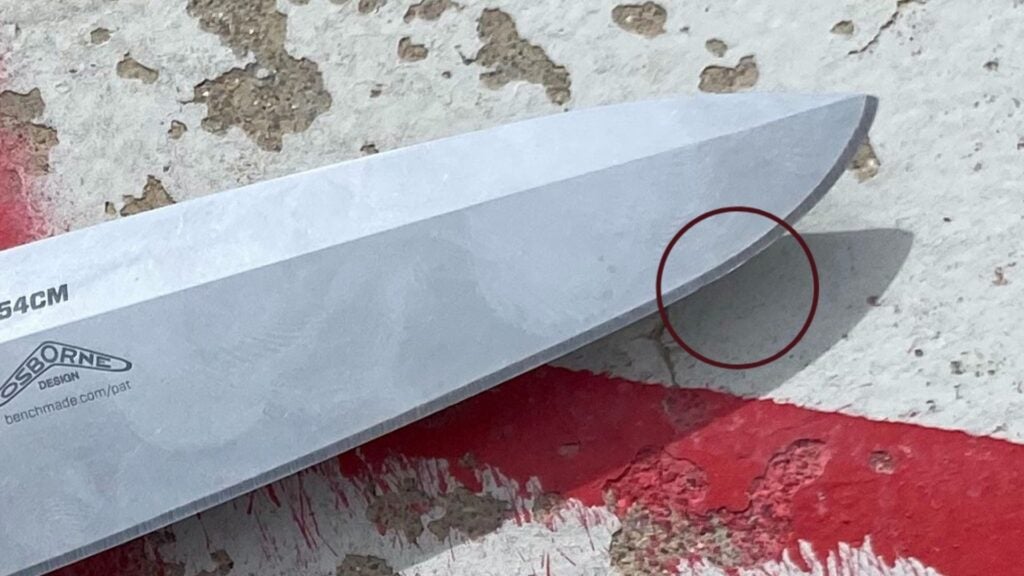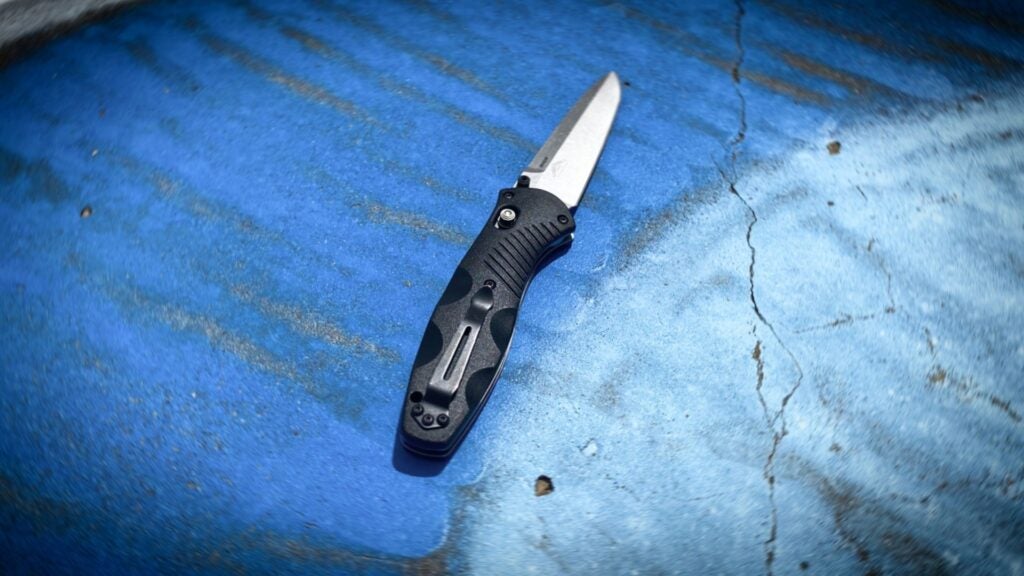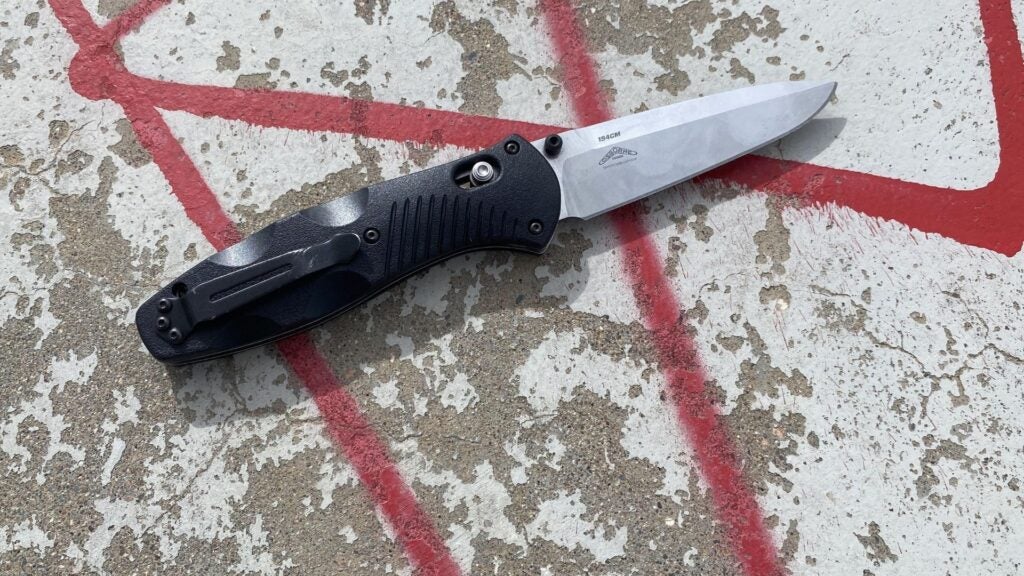Benchmade has the same sort of cachet in the knife community as BMW has in the car community. Few are surprised that the cost of these knives reaches and exceeds the $200 mark. Why? Benchmade is known for using high-quality steel alloys and intelligent knife designs that meet users’ needs. I am not surprised when I see a Benchmade retailing for $200 or more. However, I am also not the sort of knife collector with a Benchmade in my collection, at least until recently, for one simple reason: I’m cheap. I find myself using pocket knives daily. I beat them up as I open up bags of chicken feed, pry apart sections of livestock fencing, backpack in the Sangre de Cristo mountains, or troubleshoot camera equipment in the field. I do not want to break or lose a knife that represents a $200 investment.
I think Benchmade has recognized that knife collectors and demanding users do not want to spend $200 or more on a quality tactical or everyday carry knife. In response, the manufacturer has developed quality, lower-cost knives like the Bailout, the Bugout, and the subject of today’s review, the Benchmade Barrage. However, seeing Benchmade knives available in the $100 to $200 price range made me reconsider the brand and I decided to see if the brand’s mystique was hype or justified with a close examination of the Benchmade Barrage.
Blade length: 3.6 in
Weight: 4.31 oz
Material: 154CM steel alloy (blade), Valox (handel)
Unboxing
Benchmade packaged this knife in a blue mail cardstock box lined with cork-like plastic foam and a drawstring microfiber bag that can be used to clean and polish the blade and is virtually identical to the bag used for storage and polishing of Oakley sunglasses. Along with the bag, Benchmade includes a pamphlet that explains how to maintain the Barrage, how to take advantage of Benchmade’s offer of lifetime sharpening of their knives, and the lifetime warranty offered by the company.
The packaging used for the Benchmade Barrage is utilitarian. It lacks any sort of dramatic flourish compared to knives like the We Banter, where the knife came with a protective storage folio. For those that are into the whole “unboxing experience,” this could be a bit of a letdown. However, for those like me, who normally unbox products behind the wheel of their car with vague hopes of making sure the shredded remains of packaging find their way into a garbage can someday, this is more than adequate.
The Benchmade Barrage itself has a blade length of 3.6 inches, a blade thickness of 0.12 inches, and a handle length of 4.75 inches. Benchmade makes the Barrage with a plain drop point blade, a serrated drop point blade, a plain tanto blade, and a serrated tanto blade. I selected the plain drop point blade for testing, which has a flat edge grind and a satin finish. Benchmade used 154CM steel alloy, with a Rockwell Hardness rating of HRC 58-61, a substantially tough rating. The knife has a black handle made out of Valox, a type of plastic. On that Valox, Benchmade attached a pocket clip (mine arrived scratched, unfortunately), which can be mounted for either hand. The knife can also come with G10 scales, which bumps the price up substantially ($230 on Benchmade’s website). Aftermarket scales are also available for the Barrage.
The best use case scenario for this knife would be as an EDC/tactical knife. The Barrage’s ergonomic grip acts like a dagger’s front quillion, the part of the handle used to block a user’s hand from slipping forward during hard use and causing them injury. Additionally, the long swedge (the narrow, blunt top ridge of a knife’s blade) that travels the length of the Barrage’s blade makes it well-suited for tactical applications.
When we think about how to categorize a good knife, there are many different possible factors. A knife’s price can be a deciding factor, with budget knives being those that cost less than $50, mid-range knives costing between $50 and $100, high-end knives costing between $100 and $150, and premium knives costing more than $150. Similarly, manufacturing methods can be used to categorize knives, with custom manufactured knives being handmade, mid-tech knives being made, in part, with handcrafted components, and production knives being made solely on an assembly line. Based on these two criteria, we can understand the Benchmade Barrage as a high-end production knife.
Then there’s the problem of the blade, however. The Barrage arrived with a visible manufacturing flaw on the blade, a tiny chip in its edge. This is likely a burr developed during the final preparation of the knife. The flaw is small enough that it can be solved by either taking advantage of Benchmade’s offer of free lifetime sharpening or by running the knife through a manual sharpener.

How we tested
I run three general tests for knives to determine performance and then run specialized tests as needed for special-purpose knives such as hunting or diving knives. First, I test a knife’s speed in cutting five segments of paracord. Second, I test a knife’s speed in cutting a snare notch in wood. Third, I test a knife’s speed in cutting five segments of cardboard. Finally, I compare that knife’s performance against a control: the performance of one or more comparable knives in the same tests. In this particular case, I tested the Barrage against the Spyderco Manix 2 XL, a similarly sized EDC/tactical knife.
With the paracord test, I am focused on how a knife performs in probably the most common task it will face: cutting rope. Whether setting up camp or securing loads to vehicles, this is an essential task for knives. On the paracord test, the Barrage and the Manix were equal in performance. The Barrage was able to cut five lengths of paracord in 24 seconds. The Manix was also able to cut five lengths of paracord in 24 seconds. Thus, the qualitative experience of rapid cuts with the Barrage was pleasant. This is a sharp knife right out of the box, although the blade edge has flaws that I will discuss below.

With the snare notch test, I am focusing on how a knife handles sturdier material than paracord and how it can handle a common survival task. Snare notches are commonly used for trapping during survival situations. The Benchmade Barrage was able to carve a snare notch in one minute 22 seconds. The Spyderco Manix 2 XL was able to cut a snare notch in one minute 24 seconds. Again, both knives were performing equally well. However, with the snare notch test, I was able to experience a minor design flaw in the Barrage. When woodcarving, I typically will bear down on the spine (opposite the blade face) for additional force and control. The Barrage utilizes a narrow false blade edge on the spine (commonly referred to as a swedge). This swedge extends from the front of the blade all the way to within a quarter inch of the handle. This contrasts with other knives where the swedge ends well before the handle, giving the user a place to bear down with their thumb. As a result of the swedge, bearing down on the spine of the Barrage during woodcarving is uncomfortable. In part, I believe this is a bad design. I also think the Barrage was intended more for tactical use than for bushcraft or woodcarving.
I finished testing with the cardboard test, wherein I would measure how much time it would take to cut five strips of cardboard from a footlong segment. This measures the sharpness of the blade, as I try to use as little pressure as possible, by sawing downward into the cardboard instead of slashing or bearing down on the blade. The Barrage was able to cut five segments of cardboard in 30 seconds. The Manix 2 XL was able to cut five pieces of cardboard in 23 seconds. While this seven-second difference exists, it is relatively minor. However, it is also due to the aforementioned flaw in the Barrage’s blade. During the cardboard test, this chip repeatedly snagged on the cardboard. If it were not for the fact that Benchmade offers free sharpening to its non-serrated knives, I would have returned this knife.
What we like about the Benchmade Barrage
I am a fan of the Barrage, albeit with reservations. The knife is comfortable, with divots to secure a user’s fingers in place on the handle. The handle includes a substantial quillion to protect against user injury. The knife can be locked so that the Axis Assisted-Opening mechanism cannot be triggered. Unlike assisted-opening knives made by producers like SOG, the Barrage’s safety is placed between the scales rather than on the side of the handle, where it can be accidentally locked or unlocked in the pocket. The blade design is traditional but as effective as more modern or faddish designs. Finally, the steel alloy used by Benchmade for the Barrage is extremely tough. Once this knife has a proper edge, it will likely keep that edge for a long time.
What we don’t like about the Benchmade Barrage
Benchmade’s quality control failures on this knife are problems for the company’s management, which is collectively responsible for the high-cost product going out the door with flaws. The chips in the blade edge are visible to the naked eye, and I think that Benchmade’s quality assurance personnel should have caught this issue.
In addition to the chip in the blade, the Barrage’s pocket clip arrived scratched. It was also torqued on so tightly that I could not get it over the pocket of my khakis without first adjusting the tightness of the clip. This is a relatively minor problem, as I could solve it with a few minutes of adjustments. If the problem persists, there are many aftermarket pocket clips available for Benchmade knives.

However, quality control has been a problem at Benchmade, and EDC forums on the web and on Reddit have noted these problems for roughly a decade. Large retailers like Benchmade utilize social media listening software for mentions of their products and their brand name. Therefore, Benchmade has likely noticed the public perception of its quality control issues over the last several years. That Benchmade has not addressed this concern — or at least made a consumer-visible effort to address this — is disconcerting given that the brand regularly charges over $200 for its knives. I would recommend potential purchasers carefully examine their knives before use for flaws. However, they should not disassemble their Benchmade to do so, as this voids the brand’s warranty.
Verdict
I like the Benchmade Barrage and will likely make it an alternative to the Spyderco Manix 2 XL for EDC purposes. I would recommend the knife to others, but not without warning them to check their knife for defects that were missed by Benchmade’s quality assurance team. It is surprising to see Benchmade have quality assurance issues that do not occur with less expensive knives. Additionally, I think it is worth asking, with respect to Benchmade and the car manufacturer I compared it to (BMW), whether the user is buying the product for its capabilities or brand appeal.
FAQs about the Benchmade Barrage
More questions? Here’s Task & Purpose’s additional brief.
Q. How much does the Benchmade Barrage cost?
A. On Amazon, the Benchmade Barrage retails for $136.
Q. What is the best use case scenario for the Benchmade Barrage?
A. The Benchmade Barrage is a high-end tactical/EDC knife. I would consider it perfect for those in military or law enforcement roles who need a backup weapon. On the other hand, I think the Barrage is probably overkill for those who just need a day-to-day EDC knife, but your mileage may vary.
Q. What are some alternatives to the Benchmade Barrage?
A. Sadly, my beloved Spyderco Manix 2 XL is no longer on the market, as I would recommend that knife as an alternative to the Barrage. Fortunately, Spyderco has other knives that fit the bill as alternatives to the Barrage, such as the Para 3, which is currently retailing for $147. The Para 3 is not an assisted-opening knife, however, and would be a 0.6-inch decrease in blade length in comparison to the Barrage (for those that live in New York, these are positive factors for the Para 3, as the Barrage would be illegal there due to blade length and its assisted-opening feature). Additionally, for those that want assisted-opening capabilities in this size and price range, the Zero Tolerance 0350 would also be an alternative to the Barrage.
Q. Are aftermarket customizations possible with the Benchmade Barrage?
A. Because of Benchmade’s popularity, there is an extraordinary number of aftermarket scales, spacers, and pocket clips available for the Barrage.
Q. Is the Benchmade Barrage legal to carry in all 50 states?
A. While this should not be construed as legal advice, the short answer is no. Some states, such as New Mexico, have laws banning the concealed carry (such as in the pocket) of “switchblades” that are written broadly to cover knives with springs in the handle. The New Mexico statute is intended to cover only automatically-opening knives and gravity knives. Still, it does not explicitly carve out an exception for assisted-opening knives. Similarly, New York considers assisted-opening knives to be switchblades and therefore prohibited except in limited circumstances (additionally, some jurisdictions in New York prohibit knives with blades longer than three inches). I would recommend knife users check with legal resources, such as the American Knife & Tool Institute’s State Law database and summary of auto-open knife laws for further information.
We’re here to be expert operators in everything How-To related. Use us, compliment us, tell us we’ve gone full FUBAR. Comment below and let’s talk! You can also shout at us on Twitter or Instagram.
Our gear section
Todd Brogowski served in the Army as a human intelligence collector. Originally from New Jersey, he currently works as a freelance photojournalist and crime reporter in Colorado and New Mexico. Previously, he worked in the Pacific Northwest as an investigator and fraud examiner.
Task & Purpose and its partners may earn a commission if you purchase a product through one of our links. We independently evaluate gear by putting products in the hands of subject matter experts. The products we test may be purchased by Task & Purpose, our staff, or provided for review by a manufacturer. No matter the source, our testing procedures and our assessments remain free from third-party influence. Learn more about our product review process.
